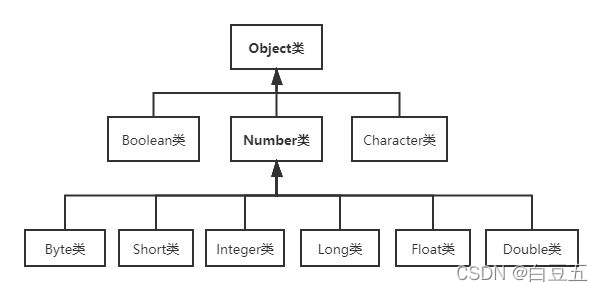-
11-包装类
包装类是Java提供的一组类,专门用来创建8种基本数据类型对应的对象,一共8个包装类,存放在 java.lang包中。
基本数据类型 包装类 byte Byte short Short int Integer long Long float Float double Double char Character boolean Boolean 包装类体系结构如下:

示例:public class IntegerDemo { public static void main(String[] args) { // 定义一个字符串 String str = "123"; // 将字符串转换成整型 int num = Integer.parseInt(str); System.out.println(num++); // 123 } }- 1
- 2
- 3
- 4
- 5
- 6
- 7
- 8
- 9
装箱与拆箱
- 装箱:将基本数据类型转为对应的包装类对象,利用各个包装类的构造方法完成。
- 拆箱:将包装类对象转为对应的基本数据类型,利用Number类的xxxValue()方法完成(xxx表示基本数据类型的名称)。
- JDK1.5之前,使用手动方式进行装箱和拆箱的操作。
- JDK1.5之后,使用自动装箱(Autoboxing)和自动拆箱(Auto Unboxing)的操作。(所以我们使用的便利是拿编译器的辛苦换来的🤭)
示例:
public class TestBoxingAndUnboxing { public static void main(String[] args) { // 1、基本数据类型变为包装类,装箱 // 通过传入基本类型数据,然后使用new关键字调用Integer类的构造方法,将其变为Integer类的对象intObj,整个过程为装箱操作。 Integer intObj = new Integer(10); // 2、包装类变为基本类型,拆箱 // 将包装类Integer类的对象intObj,还原为基本类型,并赋值给整型变量temp,整个过程为拆箱操作。 int temp = intObj.intValue(); System.out.println("整型变量temp的值为:" + temp); System.out.println("---------------分割线-----------------"); int temp2 = 345; // 3、自动装箱 //在编译阶段,编译器会自动将 intObj = temp2; 这条语句扩转为:intObj = intObj.valueOf(temp2); intObj = temp2; // 4、自动拆箱 //在编译阶段,编译器会自动将 int temp3 = intObj; 这条语句扩转为: int temp3 = intObj.intValue(); int temp3 = intObj; temp3++; System.out.println("整型变量temp3的值为:" + temp3); // 自动装箱 Boolean boo = true; // 自动拆箱 boolean flag = boo; System.out.println(flag && false); } }- 1
- 2
- 3
- 4
- 5
- 6
- 7
- 8
- 9
- 10
- 11
- 12
- 13
- 14
- 15
- 16
- 17
- 18
- 19
- 20
- 21
- 22
- 23
- 24
- 25
- 26
- 27
- 28
- 29
运行结果如下:

基本类型与字符串的转换
使用包装类的特点是将字符串变为指定的基本类型数据。
- 以Integer为例: public static int parseInt(String s);
- 以Double为例: public static int parseDouble(String s);
- 以Boolean为例: public static int parseBoolean(String s);
但是以上的操作方法形式对于字符类型(character)是不存在的。因为String类有一个charAt()方法,可以取得指定索引的字符。
示例:
public class Test3 { public static void main(String[] args) { // 定义一个字符串 String str = "3.14"; // 将字符串转为double double d = Double.parseDouble(str); System.out.println("d:" + d); //重新给字符串赋值 str = "true"; boolean flag = Boolean.parseBoolean(str); if (flag){ System.out.println("条件满足!"); }else{ System.out.println("条件不满足!"); } } }- 1
- 2
- 3
- 4
- 5
- 6
- 7
- 8
- 9
- 10
- 11
- 12
- 13
- 14
- 15
- 16
- 17
- 18
运行结果如下:

将基本类型变为字符串
使用String类中的valueOf()方法。
示例:
public class Test3 { public static void main(String[] args) { int intValue = 100; // 将整型变量转换成字符串型 String str = String.valueOf(intValue); System.out.println(str); double e = 2.718; // 将double变量转换成字符串型 str = String.valueOf(e); System.out.println(str); } }- 1
- 2
- 3
- 4
- 5
- 6
- 7
- 8
- 9
- 10
- 11
- 12
- 13
- 14
运行结果如下:

Integer数值比较
public class Test { public static void main(String[] args) { // 自动装箱,相当于 Integer.valueOf(); Integer a = 200; Integer b = 200; Integer c = 100; Integer d = 100; int e = 200; System.out.println(a == b); // false System.out.println(c == d); // true // 先自动拆箱相当于Integer.intValue();,然后再判断是否相等 System.out.println(b == e); // true } }- 1
- 2
- 3
- 4
- 5
- 6
- 7
- 8
- 9
- 10
- 11
- 12
- 13
- 14
如果整型字面量的值在-128 到 127 之间,那么不会 new 新的 Integer 对象,而是直接引用常量池
中的 Integer 对象,所以 c = = d 的结果是 true,而 a = = b 的结果是 false。 -
相关阅读:
15个Java线程并发面试题和答案
linux的sftp复制传输文件
【Java+SpringBoot】小区物业管理系统(源码+代码讲解+答辩教学+毕设选题)
Dubbo之启动时检查(check属性)。
【前沿技术RPA】 一文学会用UiPath实现自动发送电子邮件(Email Automation)
adb删除系统应用
paddle2.0简要安装过程
常见算法排序总结
如何让企业督办管理系统对接第三方应用
Redis集群
- 原文地址:https://blog.csdn.net/qq_46921028/article/details/122834698
